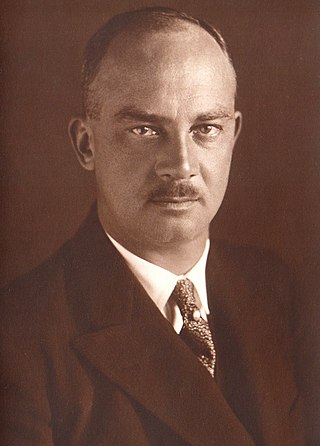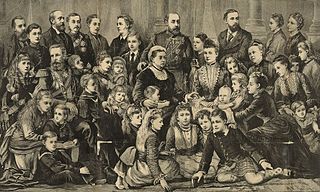
An ahnentafel or ahnenreihe is a genealogical numbering system for listing a person's direct ancestors in a fixed sequence of ascent. The subject of the ahnentafel is listed as No. 1, the subject's father as No. 2 and the mother as No. 3, the paternal grandparents as No. 4 and No. 5 and the maternal grandparents as No. 6 and No. 7, and so on, back through the generations. Apart from No. 1, who can be male or female, all even-numbered persons are male, and all odd-numbered persons are female. In this schema, the number of any person's father is double the person's number, and a person's mother is double the person's number plus one. Using this definition of numeration, one can derive some basic information about individuals who are listed without additional research.
An heir apparent is a person who is first in an order of succession and cannot be displaced from inheriting by the birth of another person. A person who is first in the current order of succession but could be displaced by the birth of a more eligible heir is known as heir presumptive.

The House of Stuart, originally spelled Stewart, was a royal house of Scotland, England, Ireland and later Great Britain. The family name comes from the office of High Steward of Scotland, which had been held by the family progenitor Walter fitz Alan. The name Stewart and variations had become established as a family name by the time of his grandson Walter Stewart. The first monarch of the Stewart line was Robert II, whose male-line descendants were kings and queens in Scotland from 1371, and of England, Ireland and Great Britain from 1603, until 1714. Mary, Queen of Scots, was brought up in France where she adopted the French spelling of the name Stuart.

Alexander Cambridge, 1st Earl of Athlone, was a member of the extended British royal family, as a great-grandson of King George III, a brother of Queen Mary, uncle to the Kings Edward VIII and George VI, and the husband of Princess Alice of Albany. He was a British Army commander, who served as Governor-General of the Union of South Africa and Governor General of Canada.

Prince Adolphus, Duke of Cambridge was the tenth child and seventh son of King George III of the United Kingdom and Queen Charlotte. He held the title of Duke of Cambridge from 1801 until his death. He served as Viceroy of the Kingdom of Hanover successively on behalf of his elder brothers King George IV and King William IV.

The Most Distinguished Order of Saint Michael and Saint George is a British order of chivalry founded on 28 April 1818 by George, Prince of Wales, while he was acting as prince regent for his father, King George III. It is named in honour of two military saints, Michael and George.

Ernest Augustus was Duke of Brunswick from 2 November 1913 to 8 November 1918. He was a grandson of George V of Hanover, thus a Prince of Hanover and a Prince of the United Kingdom. He was also a maternal grandson of Christian IX of Denmark and the son-in-law of German Emperor Wilhelm II. The Prussians had deposed King George from the Hanoverian throne in 1866, but his marriage ended the decades-long feud between the Prussians and the Hanoverians.
A queen dowager or dowager queen is a title or status generally held by the widow of a king. In the case of the widow of an emperor, the title of empress dowager is used. Its full meaning is clear from the two words from which it is composed: queen indicates someone who served as queen consort, while dowager indicates a woman who continues to hold the title from her deceased husband. A queen mother is a former queen consort, often a dowager queen, who is the mother of the reigning monarch.

Succession to the British throne is determined by descent, sex, legitimacy, and religion. Under common law, the Crown is inherited by a sovereign's children or by a childless sovereign's nearest collateral line. The Bill of Rights 1689 and the Act of Settlement 1701 restrict succession to the throne to the legitimate Protestant descendants of Sophia of Hanover who are in "communion with the Church of England". Spouses of Catholics were disqualified from 1689 until the law was amended in 2015. Protestant descendants of those excluded for being Roman Catholics are eligible.

James Hamilton, 2nd Duke of Abercorn, styled Viscount Hamilton until 1868 and Marquess of Hamilton from 1868 to 1885, was a British nobleman, courtier, and diplomat. He was the son of James Hamilton, 1st Duke of Abercorn, and Lady Louisa Jane Russell.
A Royal Fellow of the Royal Society is a member of the British royal family who has been elected a Fellow of the Royal Society. The council of the Royal Society recommends members of the Royal Family to be elected and then the existing Fellows vote by a secret ballot whether to accept them. The ballots have only a single box to tick supporting the measure; those opposing have to write "no" or otherwise mark or spoil the paper. As of 2022 the Patron was Queen Elizabeth II, and Royal Fellows were:

Queen Victoria, the British monarch from 1837 to 1901, and Prince Albert had 9 children, 42 grandchildren, and 87 great-grandchildren. Victoria was called the "grandmother of Europe".

Edward VIII, later known as the Duke of Windsor, was King of the United Kingdom and the Dominions of the British Empire, and Emperor of India, from 20 January 1936 until his abdication in December of the same year.

St George's Chapel, formally titled The King's Free Chapel of the College of St George, Windsor Castle, at Windsor Castle in England is a castle chapel built in the late-medieval Perpendicular Gothic style. It is a Royal Peculiar, and the Chapel of the Order of the Garter. St George's Chapel was founded in the 14th century by King Edward III and extensively enlarged in the late 15th century. It is located in the Lower Ward of the castle.

In the United Kingdom, state funerals are usually reserved for monarchs. The most recent was the state funeral of Queen Elizabeth II on 19 September 2022.
Since William the Conqueror claimed the English throne, succession has been determined by bequest, battle, primogeniture, and parliament.













